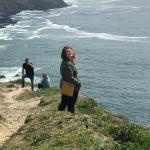With the generosity of donors and the St. Lawrence University Geology Department, I was able to travel to the Cliffs of Moher and a part of the Burren during the spring of 2019. My travels were inspired by a geomorphology project on how Ireland’s formation can teach us about plate tectonics which allowed me to understand the geological importance of many tourism spots across the country.
I spent three days in County Clare alongside my father who was born and raised in Ireland. Throughout the trip, he told me stories of his trips through Clare as a child with his father and I was able to explain the different geological formations we were looking at. It was incredibly special to be able to share this experience with my dad and be able to take him out into the field.
The Burren was an incredible area to visit. The fields of limestone were evidence of the shallow, tropical sea that covered Ireland 350 to 300 million years ago. The landscape also included exposed tilted limestone beds deformed by tectonic plate movement. This information was important to note as tectonic disturbance is not always a clear sign across Ireland, especially on the west coast.
While hiking through one of the trails within the Burren, I was able to see how the limestone eroded overtime. Not only were the erosion patterns unique, but different plants had been able to grow through the limestone rock, too. This shows the neat biological aspect of the Burren and how the area was “adjusting” to the calcium-rich rock.
The Cliffs of Moher are often referred to as one of the most beautiful places in Ireland, but they are also one of the most geologically rich. The cliffs offer a view of the layers of rocks deposited throughout Ireland’s history. The rocks that make up the cliffs include shale, siltstone, and sandstone. Each one of these rocks represents an important part of Ireland’s geology and the environment it was in at the time of deposition.
I was also able to spontaneously visit Europe’s largest free-hanging stalactite. During the tour, I learned about two young men who ventured into a tight cave and discovered the area we were able to walk through. The tour guide noted many different geological features throughout the cave including fossils, speleothems, and many of the forces that made the cave itself.
There was a boat tour that brought tourists down to the base of the cliffs to look up at them. I thought this would be an incredible way to view the strata as the sight from the top of the cliffs can be limiting. Between boat-sickness bouts, I was able to see the magnitude of the cliffs towering above us. Being able to see the Cliffs of Moher from the sea was very eye-opening since it gave me an idea as to how much time it took to create these cliffs due to the immensity of the rock layers.
Between geological studies, my father and I visited places like Gus O’Connor’s Pub, which is a place my parents often visited during their time in Clare. Between traditional Irish folk songs sung by a folk group, my father and I discussed the Irish culture, his childhood, and how my semester in Denmark went. This time was something I will always cherish as it was an incredible experience to have, especially alongside my dad.
